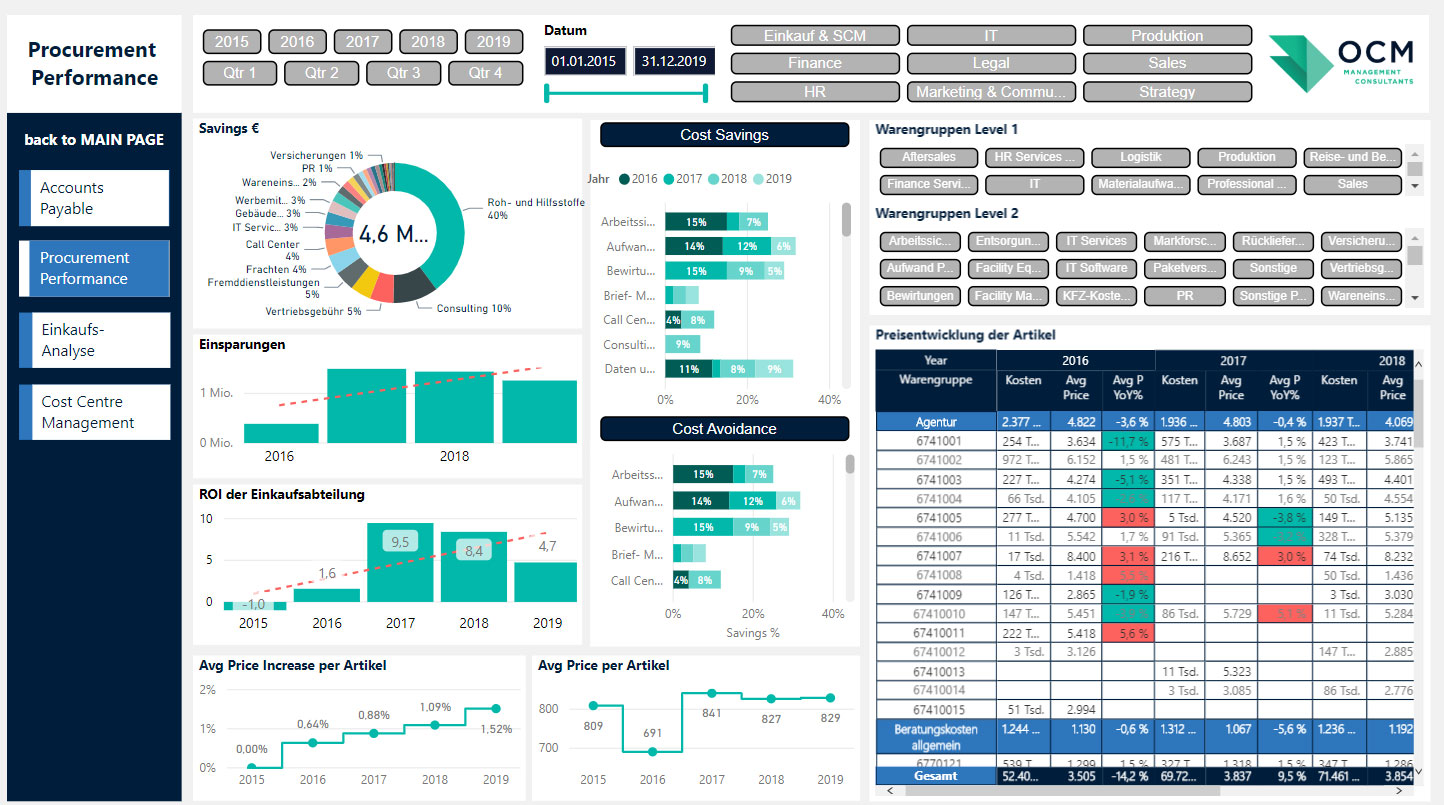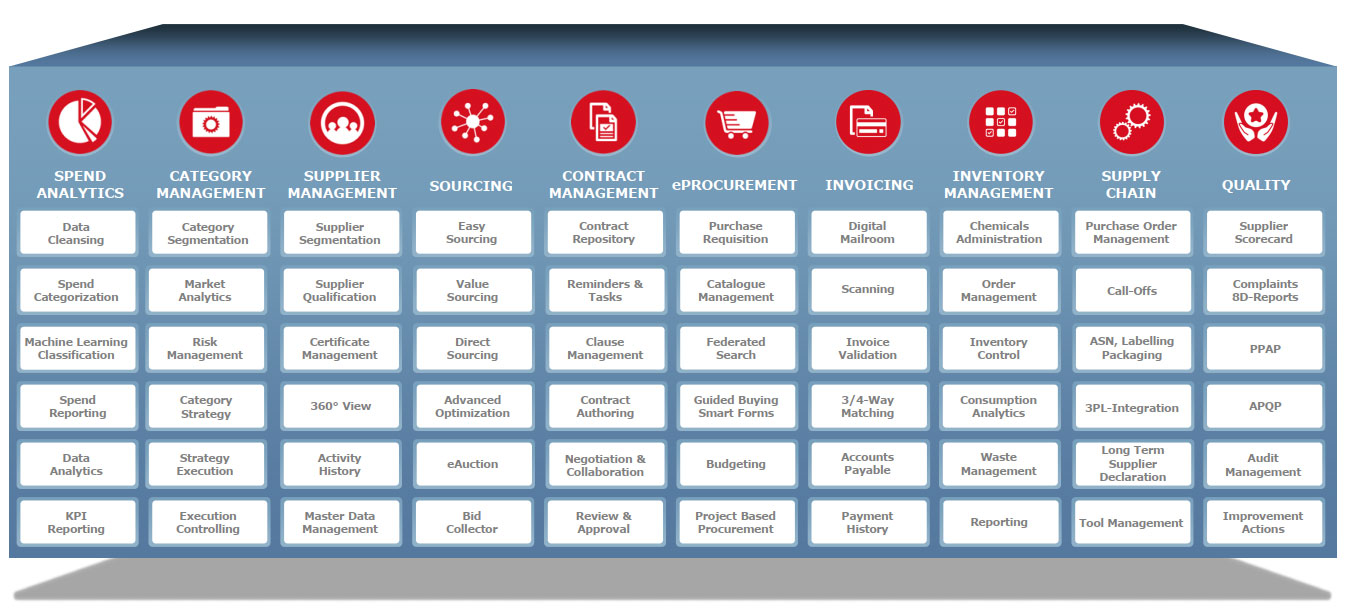- Procurement Strategy
- Procurement Management
- Procurement Transformation
- Strategic Procurement & Category Management
- Operational Procurement
- E-Procurement

E-Procurement: Procedure, Pitfalls, and Solutions
Everybody is talking about the future of procurement: digital procurement processes, procurement analytics, and Procurement 4.0. Find out here how you can improve the performance of your procurement department through faster information flow, the automation of work steps, and access to technologies. We discuss questions such as:
- When does e-procurement make sense and when does it not?
- E-procurement - what is the right approach?
- Agile or classic - which is the best approach for digitalising procurement?
- What are the common pitfalls? How should they be avoided and what are the solutions?
After answering these questions, we discuss typical challenges and potential solutions and provide an outlook on how you can contribute to the future success of your company through digital procurement.
When does e-procurement make sense and when does it not?
A company should first be aware of exactly what it wants to achieve through digitalisation and which areas will be affected. Many companies claim to have digitalised entire corporate divisions - but what does that mean in concrete terms?
Digital procurement can be narrowed down to 3 essential objectives:
- Data and information enhancement
- Work process or procurement process optimisation
- Support of management processes
In order to achieve added value through digitalisation, you should ask yourself what goal you are pursuing, which areas are specifically affected, and which areas will benefit.
In digitalisation, even with the vision of holistic digitalisation, it is advisable to think in terms of tangible initiatives, to evaluate each initiative in terms of its effort and benefit, and to ensure collaboration and integration towards a holistic goal.
Example based on a reference project with the objective: Building an interactive business intelligence dashboard for strategic procurement
The dashboard, which is automatically updated on a daily basis, provides analysis support for negotiations and the category strategy and thus reduces the analysis time per buyer by approx. 40%. Meaningful procurement analytics improved negotiation results by 3% on average. The monitoring of the maverick buying rate resulted in channeling an additional expenditure of 400k Euro through framework agreements with the preferred supplier at an average saving of 11%. An investment of 20k Euro leads to expected savings of 80k Euro.

Alongside the added value of each initiative, it is essential to take into account the necessary prerequisites and investment costs. Practice shows that many companies purchase software solutions without taking into account the mandatory requirements for data availability, training, and connection to the internal technology landscape or suppliers. Even within software systems, the range of solutions often exceeds what is required for each individual case. Systems are also often purchased with the aim of improving procurement process efficiency and adapted to the company's own processes – if software is adapted, you should have thoroughly checked beforehand whether the company's own processes are optimal.
In the following situations, you should refrain from digitalisation as a first step:
-
No digital procurement without a real strategy and value-add testing for your company
-
No digitalisation of inefficient procurement processes without optimising them first
-
No digitalisation of procurement processes when data requirements cannot be met by the digital solution
-
No digital procurement as long as it poses a risk to critical day-to-day operations
So when does digitalisation in procurement make sense? When a specific initiative is positive in its cost-benefit analysis, when all mandatory requirements for the functioning of the digital solution have been evaluated and fulfilled, and when the solution is suitable and feasible in terms of systems and processes.
E-procurement: what is the right approach?
Step 1: Analysis of the as-is situation
First, collect and identify pain points that exist in the area under consideration. Identify possible solutions and alternative actions. Evaluate the extent of the pain points and the effectiveness of the digital solution. Check prerequisites, dependencies, and other risk factors of a possible implementation. Is it an already available software solution or is in-house development possible and reasonable? What resources are necessary: programming, specialist resources, IT resources?
Develop a realisation strategy for testing and implementing the digitalisation opportunities and present it for a go/no-go decision.
Step 2: Realisation of the digitalisation initiative
Check and evaluate the realisation possibilities. Regardless of whether there are existing software solutions or whether you want to program your own - first define the objective and the path to a solution .
To do this, consider the business requirements and the optimal process, data availability, and other user requirements. Use-cases are a good way to do this, describing in concrete terms how the business benefits that are ultimately at stake will be achieved.

solution for e-procurement and P2P
In the case of in-house development, work with the required resources on a blueprint of the solution then evaluate and plan the realisation phase in milestones with concrete dates and the functional statuses to be achieved.
In the case of external software, find out what is on offer and compare it with your requirements and objectives. Demos and supplier presentations are a good way to drive the selection process.
In both cases we recommend a pragmatic implementation via one or more Proofs of Concept (PoC). Here, both in-house programming and external solutions can demonstrate their degree of suitability for achieving objectives. This check should be as fast, cost-effective, and risk-free as possible and enable you to make the decision on whether to roll out.
Step 3: Roll out the procurement digitalisation initiative
Once the decision has been made to roll out the solution, the first step is to draw up an implementation plan. Risks, such as the impact on day-to-day business or rejection of the change by the employees involved, must be identified early on and counteracted. Targeted information, the motivation and involvement of the affected users, as well as a step-by-step approach, will help you with the roll-out. A well-functioning project management process should regularly report on difficulties and successes and, if necessary, provide steps for mitigation. Training based on user-related exercises that demonstrate the benefits for the user help with integration into everyday processes.
Agile or classic - which is the best approach for introducing e-procurement?
The answer is: it depends. Both project management methods have their advantages and disadvantages and their raison d'être.
The fundamental difference is that in classical project management it is assumed that a final state can be described and the production process up to that point can be planned in detail and evaluated in terms of effort and costs. Unforeseen events consequently require an adjustment to effort and costs or, to a certain extent, a complete readjustment.
The agile project methodology is an iterative-incremental approach, which aims to deliver a usable component of the overall solution after each work phase. In short work phases, the team pursues a product vision and tries to consider product wishes in a prioritised backlog. This flexible approach enables continuous re-prioritisation and fast, cost-efficient adaptation.
Bearing this difference in mind, it can be said that in the case of complex integrations, unknown technologies, or a high risk of unforeseeable events, an agile project methodology is to be favored. Their disadvantage is that they produce less predictable results and costs and have an increased communication and coordination effort.
Classic project methods are significantly more efficient and successful in this respect if the complexity is low and the risk of unforeseeable events is low.
In both cases, we recommend a proof of concept, which can demonstrate the most crucial elements of added value in a small and quickly accessible environment.
Are we on the right track?
Use the following check-up questions to determine whether your strategy for e-procurement or your current initiative is on the right track:
- A clear strategy with concrete plans has been formulated by examining all prerequisites and is anchored in the objectives of the initiatives
- There is a clear roadmap with firm test dates at which certain aspects of functionality are presented in terms of their practical added value
- Resources with appropriate experience and overall vision were involved in the design of the implementation plan
- The selected project method and control are suitable for the digitalisation project
We would be happy to support you through dialog or discussion to evaluate your procurement digitalisation strategy or specific digitalisation project.
What are the common practical pitfalls and what are the solutions?
In order to provide insight into some avoidable mistakes or to identify adverse situations at an early stage, we describe below some typical examples in which a procurement digitalisation initiative faced failure. The approach in each of these cases can be used to prevent such problems reoccurring, and, where necessary, find solutions.
So far, no end-to-end solution for digitalising the entire procurement process has been established. This leads to companies accessing and implementing a number of individual solutions, and often results in interface modifications and errors as well as the missed synergies of networking with other divisions and functions. The potential of digital procurement is not only missed, but this situation can also lead to additional costs and wasted time – the very opposite of the objective of digitalisation.
In developing a strategy for digitalisation, we help our customers derive goals for e-procurement based on the company-wide digitalisation strategy. The target operating model typically encompasses three main elements:
Improved information availability, procurement analytics, and dissemination:
- Real-time availability of information for earlier error detection and the avoidance of risks
- Improved data quality and data availability to increase the meaningfulness of information
- Vertically and horizontally simplified communication using seamless technologies
- Improved controls and an improved basis for decision making
- Faster reaction to market changes and trends
- Improved evaluation of customer and supplier data leading to more targeted activities and the development of tailored, needs-based products/material requirements
Cost-, quality- and time-optimised processes:
- Increase of reaction speed (inquiries, orders, complaints, evaluations, etc.)
- Reduction of personnel costs for autonomous processes
- Quality improvement through reaction speed and error avoidance
Optimisation of management activities:
- Improved personnel planning and management
- Improved measurement and control of procurement
- Decision optimisation through provision of the relevant information at the time of decision
- Integration of procurement-relevant objectives and challenges into adjacent specialist areas through networking with adjacent systems
After the objectives have been evaluated and the most relevant identified, the actual initiatives that seek to achieve these objectives must be derived. Based on these initiatives, we jointly draw up a project plan for the medium to long-term implementation of procurement's digitalisation.
A key danger is selecting software that does not meet your specific needs. Many companies do not succeed in combining technical procurement competence with the necessary IT understanding in order to find a digital solution that meets the requirements of both. The consequences are: over-specified and therefore prohibitively expensive solutions; un-connected and isolated solutions which fail to realise their potential; or digitalisation projects which take too long or the results of which do not fulfil the desired objectives.
We combine technical expertise, IT understanding, and the necessary project management skills to support our clients in the selection, negotiation, and implementation of suitable solutions. We take care to record the requirements of our clients with regards to the target operating model(s) and the desired size of the change, and then have best-in-class providers demonstrate how they will satisfy these requirements. It is crucial to involve the relevant departments in the selection process and to carry out the selection process in a methodical and efficient manner. To that end, in the implementation phase, it is essential to assign responsibility and a deadline to each process step, and to empower project management with a sufficient mandate so they can complete the project efficiently and within budget.
Rapid technological progress has produced some outstanding solutions for the collection and evaluation of information and the deduction of value-adding initiatives. In addition to selecting the right software to match the strategy and IT landscape, the right application should also fulfill the requirements of personnel and be integrated into the team in an appropriate manner. Experience shows that a combination of skepticism towards innovation as well as insufficient skills and knowledge in the use of novel solutions inhibits or even prevents the success of digitalisation.
New software and digital tools always require promoters and supporters. Additionally, regular training and the monitoring of actual use is essential to ensure that employees acquire the necessary knowledge and practice. An effective supplement to this is the introduction of so-called super-users, who are available for questions and queries at any time and promote mutual learning in the team. For all of the above we create a training and education plan for our clients in order to implement digitalisation in a sustainable manner, which, if necessary, we can support.
Outlook and conclusion on e-procurement
Digitalisation as a disruptive use of technology is becoming increasingly important and will potentially lead to a competitive revolution in the way companies procure over the next few years.
Digital procurement solutions can have added value in 3 dimensions to leverage staff efficiencies, reduce purchase prices through better negotiation and supplier selection, and avoid costs caused by a lack of transparency and inefficient management:
- Improved information availability, evaluation, and dissemination
- Cost, quality, and time-optimised processes
- Optimisation of management activities
The ability of a company to create competitive advantages through digitalisation at an early stage without losing its interconnectedness could therefore become essential for survival.
OCM offers comprehensive support on your path to digital procurement. We support you in the design of your customised digital strategy as well as its implementation also in combination with our comprehensive service offering in procurement. We combine our proven approach in procurement strategy and management, procurement process optimisation, and the know-how of strategic procurement of individual categories with the digitalisation of your procurement department. We would be happy to present our approach and modules in this regard or discuss specific issues and possible solutions based on your challenges.

Our project modules at a glance:
Procurement Consulting Modules
Procurement Opportunity Assessment
- Benchmarking & Identification of Opportunities
- Tangible Action Plan for Implementation
External Cost Transformation
- Reduce costs & stop maverick buying
- Procurement Optimisation & Zero-Based Budgeting
Procurement Process Optimisation
- Procurement processes optimisation: fast, cost-efficient, digital
- Trained and invested employees
- Improving compliance
Strategic Sourcing
- Procurement Strategy & Cost Optimisation
- Increase quality & prevent maverick buying
Procurement Strategy Design
- Sustainable max. value contribution through optimal procurement strategy
- Reduce costs, optimise procurement processes
BI Cost Reporting
- Consolidated data sources
- Meaningful live analyses
- Fact-based decision making
Procurement Operating Model
- Maximising the value-add of the procurement organisation
- Optimise, measure, & control procurement processes
Training: Strategic Sourcing & Negotiation
- Buyers trained as specialists
- Putting theory into practice and implementing with support
Interim Procurement Manager
- Rapid response: candidates within 48h
- Matching of requirements and assessment of suitability using procurement experts
- From operational buyer to CPO
Should Cost Analysis
- Should Costing als Methode der Einkaufsoptimierung
- Der Weg zu Should Cost Analyse & Should Cost Modell
Digital Procurement
- Competitive advantages in speed, scope, & significance of information
- Efficiency through automation, data integration, & process simplification
Workforce Management
- Procure-to-pay cost reduction
- Fraud prevention
Supplier Management
- Efficient Cooperation
- Performance-based Supplier Management
Insurance Optimisation
- Cost Optimization
- Bespoke Optimal Insurance Cover